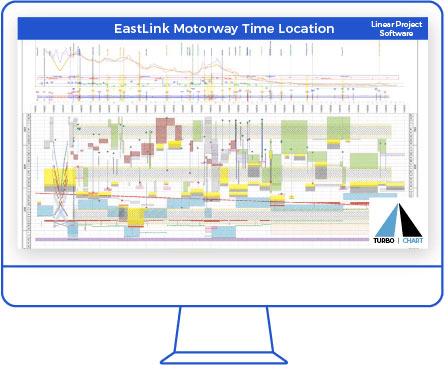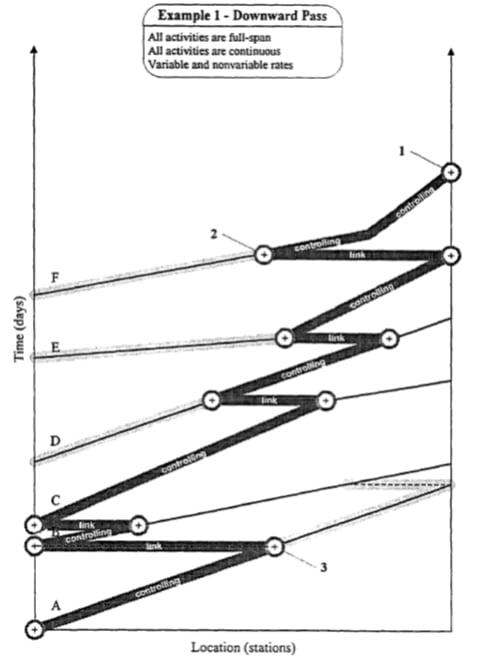Frequently Asked Questions
The term Linear Scheduling has been used interchangeably to mean two separate albeit similar meanings – the method: Linear Scheduling, versus the output: Linear Schedules
Comparing Turbo-Chart and Tilos Training
Linear Scheduling also known as the Linear Scheduling Method is the development of project schedules that take into consideration, elements of the work that are linear, continuous or repeated. This can include physical details such as:
- where these activities occur
- the quantity of work that determines task duration
- production rates for the crews and the work being performed
- production rates for the crews and the work being performed
- relationships (by time or by physical location) to other tasks occurring on the project
However, in most common use, the term linear scheduling is used to describe the process of preparing linear schedules – graphical representation of the project schedule, even if linear scheduling techniques are not applied. For example, the development of a traditional CPM schedule in conjunction with a linear schedule graphic might also be called linear scheduling.

The Six Features
Linear Schedules are also known by a variety of other names e.g. Time Chainage (see Time Chainage Software), Line-of-balance etc. The terms linear scheduling and linear schedules appear to be mostly used by users and organisations that are US based, whereas the other common terms such as Time Location (see Time Location Distance Diagram Chart) or Time Chainage charts are more prevalent amongst UK and European users and organisations.
All of the previously mentioned methods have common location based features where one axis on the chart represents time and the other axis represents the physical or linear element of the project, and schedule activities are then depicted upon this grid with the co-ordinates defining when and where activities start and finish. A range of display methods such as line style, colour, shapes and fill patterns may also be adopted to present differing activities in different formats.
True linear scheduling identifies controlling activity paths from the linear schedule using an upward and downward pass similar to a forward and backward pass of traditional CPM scheduling. The following diagram from a 1995 paper by David John Harmelink titled “Linear scheduling model: the development of a linear scheduling model with micro computer applications for highway construction project control” provides an example of how. Linear Scheduling Software that applies true linear scheduling methods is not yet known to be commercially available, however a number of software tools are available, that produce linear schedules using the methods described below.

This method is the generation of linear schedules manually by essentially drawing the schedule tasks onto grid of time vs location. This method has historically been achieved even using pen and paper, however modern software applications can adapt similar methods, including drawing packages, Computer Aided DEsign (CAD) systems, or charts linked to spreadsheet values.
Benefits of this approach are:
- some of these tools already exist amongst users and their organisations
- such methods require little training/learning to apply
- the cost of software applications to do such is minimal
Issues with this method are:
- the output may contain errors due to manual translation of data from other systems
- the outputs maybe quite “static” in that reflecting schedule updates may be a cumbersome, time consuming process
- there are limited options in terms of modifying the output displayed (eg. filtering, scaling etc)
- generally a non-scaleable approach – each new project requires the development of a new linear schedule, there is little opportunity to re-use past outputs as templates
This method relies on the CPM schedule to contain the data that is then presented in Linear Schedule format. Additional data is appended to the CPM Schedule to be used to present task data on the time and location axis of the linear schedule. Specialised software for the presentation of this data is able to convert the CPM schedule data into the linear schedule format but does not return data to the CPM schedule. Ie. a one-way flow of information
Any manipulation to the linear schedule must also be made in the source CPM schedule and the linear schedule is refreshed to display the modifications.
Benefits of this method are:
- Users are not required to learn new scheduling tools
- The unidirectional transfer of data can be a quick process due to being simply a graphical representation – no calculations are required
- Software to produce linear schedules in this method are typically low cost
Schedule data is contained in one source
Issues with this method are:
- CPM schedules may require additional tasks and relationships to meet linear scheduling principles
- Requires additional data to be maintained in the CPM schedule, in addition to the standard scheduling requirements.
This method allows the generation of Linear Schedules by either adding location values to existing CPM Schedule data, then presenting that into a linear schedule format, but allows the manipulation of the schedule data on the linear schedule to be fed back into the CPM schedule.
To meet CPM scheduling requirements, the physical constraints that exist when working in linear schedules are represented through the manipulation of activity durations, activity splitting, and the use of relationship lags.
Benefits of this method are:
- Linear aspects of a project may be viewed in whichever format is desired by the users
- Data contained in CPM Scheduling tools may be used in Linear
- Scheduling tools by the addition of extra location based values
CPM principles such as critical path and float are maintained
Issues with this method are:
- To understand the manipulation of schedules to meet both CPM and Linear requirements requires significant training and learning
- The sophistication of such tools makes them significantly costly compared to other methods
- Often, only the linear elements of the CPM Schedule converted to the Linear Schedule, and any modifications to the schedule made must then be validated being fed back into the CPM Schedule
